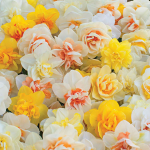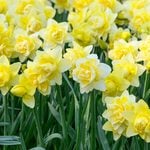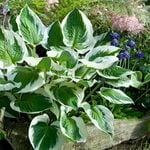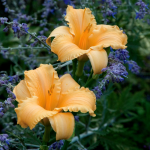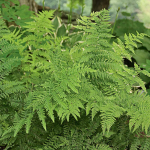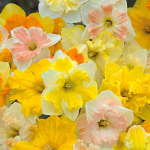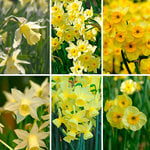Daffodil Care
Latin Name Pronunciation: nar-sis'-us
Bulb size: 12-16 cm; miniature varieties 8-12 cm
Harbingers of a new season, spring-flowering Daffodil Narcissus light up the landscape. Glorious gold, lemon-yellow, and snowy white blooms are often accented with contrasting trumpets or centers and vary in height from two inches to two feet with flowers in elegant proportion. Easily grown, the majority of Daffodil bulbs are very tolerant of cold winters. Paperwhite Narcissus are hardy only to Zone 8, but are forced indoors in pots in cold climates during the winter months for their fragrant blooms. Many of the hardy varieties can also be successfully forced indoors. Many Daffodils can be grown throughout the South, except in regions that are frost-free, since cold temperatures are necessary for the formation of the flower buds.
How to Grow Daffodil Narcissus
Light/Watering: While Daffodils prefer full sun they will usually tolerate half-day shade, especially Cyclamineus hybrids such as 'Jack Snipe' and the Poeticus variety 'Actaea'. Those cultivars with orange, red, or pink cups generally retain deeper color when planted in a location that receives protection from the hot afternoon sun. Watering during the fall is essential for good root growth before the ground freezes in cold regions. Try not to water excessively in the summer months when bulbs are dormant.
Fertilizer/Soil and pH: Daffodil bulbs will not survive in soils that are wet, especially during the winter. Avoid low-lying areas where water gathers or where the snow is late to melt in spring. Plant bulbs at a depth 3 times their height. Daffodil Narcissus bulbs appreciate deep planting in light soil. If your soil is heavy, try planting less deeply than we recommend, making up the difference with a layer of mulch on top. Plant larger or bedding-size bulbs 5–6″ apart (4–5 bulbs per sq ft), smaller or landscape-size bulbs 3–4″ apart (5 bulbs per sq. ft.), and the miniatures 3–4″ apart (5 bulbs per sq ft). When planting, keep in mind that the blooms tend to face the prevailing direction of the sun; in a border viewed from the north, they will look away from you. Do not separate bulbs that are attached at the base; the smaller bulb (known as an off-set or a "daughter" bulb) should not be detached from the parent bulb before planting. The best time to fertilize is in the autumn, when the bulbs are sending out new roots. To make clumps of Daffodils easy to find, plant a few Grape Hyacinths (Muscari) amongst them; the Grape Hyacinths send up a bit of leaf growth in the fall. The next best time to fertilize is in early spring, just as the Daffodil foliage begins to push through the soil. We recommend using a granular slow-release fertilizer formulated especially for bulbs.
Pests/Diseases: Few if any pests bother Daffodils. The bulbs and foliage are poisonous to most insects and animals, including deer and voles. If you see vertical streaks in the Daffodil leaves, dig up the bulb and put it in the trash as it may be infected with a virus. Watch any surrounding Daffodils for symptoms as the virus is spread by contact.
Companions: Narcissus reach dormancy 6 to 12 weeks after flowering depending on weather and variety. The period between the end of flowering and the withering of the foliage is crucial to the future vigor of the plant. If you cut, fold, or braid the leaves before they have yellowed and collapsed, you may prevent the bulb from storing the energy required to bloom the following year. You can hide curing foliage by interplanting bulbs with leafy perennials such as Brunneras, Hostas, Daylilies, and Ferns or by adding annuals including Vinca (Madagascar Periwinkle), Impatiens, and Begonias after the Daffodils have bloomed. If you plant the bulbs in a lawn, do not mow the grass until the bulb foliage begins to yellow. Daffodils do well under deciduous trees, but avoid planting under evergreens and in areas where large roots are close to the surface.
Dividing/Transplanting: The best time to move or divide bulbs is when their foliage has withered, signaling the end of active growth. Lift them with a digging fork or a spade, taking care to avoid injuring the bulbs, and replant them immediately at the same depth and about three times their diameter apart. Water well.
Calendar of Care for Daffodils
Early Spring: Fertilize now if you missed the fall opportunity.
Late Spring: Water if the season has been dry, and deadhead as needed. Watch for vertical lines in the foliage and remove and destroy any bulbs showing signs of viral infection.
Summer: Try not to overwater in areas where Daffodils are planted. Allow foliage to cure naturally without intervention.
Fall: Use a granular slow-release fertilizer to feed Daffodil bulbs now. Gently lift and divide clumps of bulbs now. Plant new bulbs and include a few Grape Hyacinths to mark the planting spot. Remove dead foliage, and mulch with evergreen boughs after the ground has frozen. Water bulb plantings thoroughly through the fall if rain is scarce.
Types of Daffodils
Trumpet Daffodils
These are the classic flowers of spring, the ones that come to mind when you imagine a "host of golden Daffodils." Trumpets are the best Daffodils for bedding, with a single big, bold flower per stem. They generally perform better in the middle and northern states then they do in the Deep South. A Daffodil is officially classified as a Trumpet when the cup, or corona, is as long as or longer than the perianth. Some common varieties are 'Dutch Master', the successor to the venerable 'King Alfred' as the all-around best Daffodil money can buy, and 'Mount Hood', an outstanding white Trumpet that made its debut in 1937 and has continued to win awards over the years.
Large-Cupped Daffodils
These are the workhorses of the Daffodil world because they're good for every possible use: bedding, cutting, naturalizing, forcing, and showing. This class includes the full color range: white, every shade of yellow, orange, red, and pink. All large-cupped Daffodils bear one flower per stem with two or more stems per bulb.
Double Daffodils
Instead of a trumpet, these Daffodils have a central cluster of petals and are almost roselike in form. Doubles have from one to as many as 20 flowers per stem and are good for show, bedding, and cutting.
Jonquilla Daffodils
Several small, fragrant flowers per stem are held above narrow, grasslike, dark green leaves. The bulbs naturalize well, creating beautiful sweeps of color. This Daffodil group likes hot, baking summer sun. It is well adapted to the Deep South but also thrives in cooler parts of the country. There are two or more stems per bulb.
Miniature Daffodils
This group includes every form of Daffodil flower in a petite package, usually 6in or shorter. These little bulbs are excellent for rock gardens, the front of the border, niches between tree roots, and forcing. They are also beautiful in patio containers if protected from freezing north of Zone 7. The bulbs vary in size, but most are the largest grade available and produce two or more flower stems per bulb.
Small-cupped Daffodils
Crisp, brilliant colors characterize this group of long-lived perennials. Small-cupped Daffodils are great for naturalizing and contribute rich color to a mixed border in the spring. The flowers are also superb for cutting. Each stem bears a single flower.
Split-corona Daffodils
These are unusual flowers, quite unlike most Daffodils. The cup is split for at least one-half its length, creating an open face instead of the typical trumpet. Many of the flowers look more like a Hibiscus than they do a Daffodil. One of the showiest groups for mass plantings in the landscape, these large, up-facing blossoms provide more color for the dollar.
Frequently Asked Questions
When to plant Daffodil bulbs?
Daffodil bulbs should be planted in the fall. Plant when the soil is cool, but not frozen, so that you can still work the soil. This is usually between September and November, depending on where you live.
Can you plant Daffodils in the spring?
Sadly, no. Daffodil bulbs should be planted in the fall.
Do Daffodils spread?
Yes. They settle in quickly, bloom beautifully their first year, and then increase their numbers in the kind of sunny, well-drained site they like.
How deep to plant Daffodil bulbs?
Plant Daffodil bulbs at a depth 3 times their height.
Planting Daffodils in pots
Read our blog post that covers everything you'll need to be successful to grow your Daffodils in pots.
How to plant Daffodils bulbs
It's easy to plant your daffodil bulbs: you’ll just want to plant the bulbs at a depth of 3 times their height and dig a large enough hole to accommodate the spacing each bulb will need, if you're planting in clumps. Larger bulbs should be planted 5–6" apart, smaller or landscape-size bulbs 3–4" apart, and the miniatures 3–4" apart.
How to plant Daffodils in drifts
Some gardeners prefer Daffodils (Narcissus) scattered across the landscape as impressionistic points of color. Others prefer them organized by variety into drifts of solid color. Nature does it both ways, and so there is no right or wrong style for your bulbs. The choice is yours.
A planting plan should aim for irregular, long ovals, wide in the middle and tapering at the ends. Some drifts should be larger, some smaller. If you decide to create a planting plan on paper first, draw a line down the center of your paper, and arrange the drifts so that most will cross that center line at their tips, or occasionally, a third of their total length. You may prefer to create your plan directly outside on the ground where the bulbs are to be planted (keep in mind that Daffodil flowers usually face towards the direction of the sun, so drifts viewed primarily from the north will have their flowers looking away from you). Form the shapes of the drifts with sections of rope or garden hose and adjust them to suit your site in a natural-looking way. Remember, the point is to please your eye, not stick to a blueprint.
Once you are generally satisfied with the shapes, you are ready to fill them in with bulbs. Each drift should contain only one Daffodil variety. Check the plant labels for information on height, color, and bloom time—this will help you decide which variety to place in which drift. For example, you may wish to place the earliest-blooming variety in the drift that's farthest away and the latest blooming one in the closest drift, so that the sequence of bloom moves from back to front (early flowers that have gone by will thus recede from view). Or you may want to place a variety of a certain height or color in a particular drift.
Next, set or gently toss the bulbs of one variety into a drift. The bulbs should not be evenly spaced, nor too close or far apart. Once you are satisfied with the arrangement, start planting the bulbs at the depth indicated on the label. Repeat this process for each drift.
What to do with Daffodils after flowering
Once bloom is complete, allow the leaves to remain in place until they yellow (8-10 weeks). Do not cut back or mow the foliage until it has died down completely. If you cut the leaves before they have yellowed and collapsed, you may prevent the bulb from storing the energy required to bloom the following year and create larger clumps each year. To hide curing daffodil foliage you can interplant with leafy perennials and annuals, see our Daffodil companion suggestions.
What is the easiest way to plant Daffodil bulbs?
The simplest way to plant Daffodil bulbs is to scatter them across the ground in the area where you wish to plant them in the fall. Then, just dig a hole 3 times the height of the bulb, place your bulb in the hole, and cover the hole with soil.
We offer two tools to help make Daffodil planting easier. If you are looking to plant Daffodils in a border, try our Bulb Planter for Borders. If you are looking to plant your bulbs in the lawn, in a meadow, or in the woods, try our Bulb Planter for Naturalizing.
What to do if my Daffodil flowers are frozen?
If your Daffodils are blooming outdoors and frost or snow causes them to lean over, the best thing you can do is avoid touching them. Simply let the plants thaw out naturally. Handling the plants while they are frozen can cause the plant cells to rupture. Daffodils may recover from a brief freeze, but they may not rebound if their cells have been damaged.
Do Daffodils come back every year?
Yes, Daffodils emerge from the ground on their own in early spring, year-after-year. They provide a big reward with their colorful blossoms but require little to no maintenance.
Video: How to Plant Daffodils
Shop All Daffodils
Daffodils We Offer:
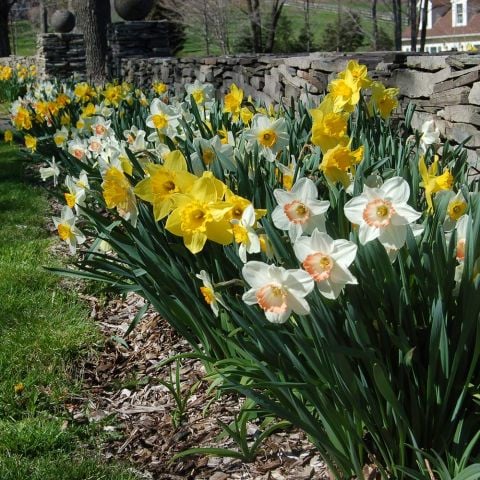 The Works Daffodil Mix
The Works Daffodil Mix
Daffodil Companions
Garden Images of Daffodils


